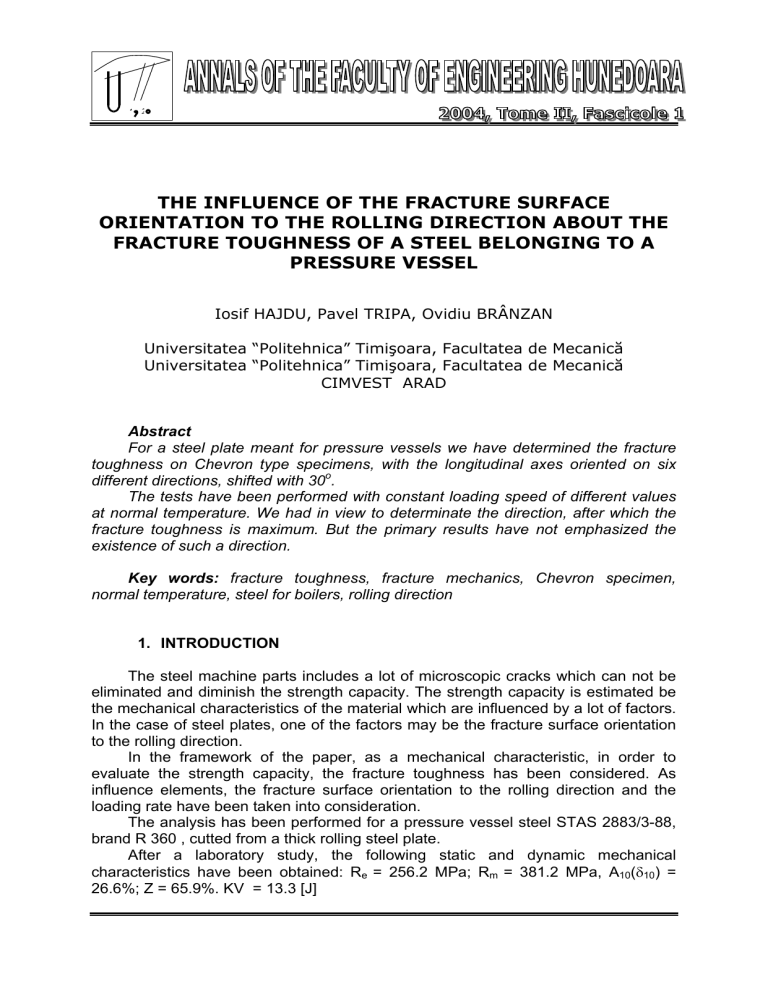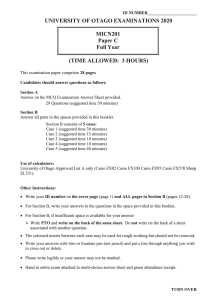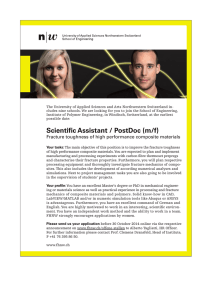
1 2 THE INFLUENCE OF THE FRACTURE SURFACE ORIENTATION TO THE ROLLING DIRECTION ABOUT THE FRACTURE TOUGHNESS OF A STEEL BELONGING TO A PRESSURE VESSEL Iosif HAJDU, Pavel TRIPA, Ovidiu BRÂNZAN Universitatea “Politehnica” Timişoara, Facultatea de Mecanică Universitatea “Politehnica” Timişoara, Facultatea de Mecanică CIMVEST ARAD Abstract For a steel plate meant for pressure vessels we have determined the fracture toughness on Chevron type specimens, with the longitudinal axes oriented on six different directions, shifted with 30o. The tests have been performed with constant loading speed of different values at normal temperature. We had in view to determinate the direction, after which the fracture toughness is maximum. But the primary results have not emphasized the existence of such a direction. Key words: fracture toughness, fracture mechanics, Chevron specimen, normal temperature, steel for boilers, rolling direction 1. INTRODUCTION The steel machine parts includes a lot of microscopic cracks which can not be eliminated and diminish the strength capacity. The strength capacity is estimated be the mechanical characteristics of the material which are influenced by a lot of factors. In the case of steel plates, one of the factors may be the fracture surface orientation to the rolling direction. In the framework of the paper, as a mechanical characteristic, in order to evaluate the strength capacity, the fracture toughness has been considered. As influence elements, the fracture surface orientation to the rolling direction and the loading rate have been taken into consideration. The analysis has been performed for a pressure vessel steel STAS 2883/3-88, brand R 360 , cutted from a thick rolling steel plate. After a laboratory study, the following static and dynamic mechanical characteristics have been obtained: Re = 256.2 MPa; Rm = 381.2 MPa, A10(δ10) = 26.6%; Z = 65.9%. KV = 13.3 [J] ANNALS OF THE FACULTY OF ENGINEERING HUNEDOARA – 2004 TOME II. Fascicole 1 2. SPECIMENS AND EXPERIMENTAL INSTALATION In order to estimate the fracture toughness, the Chevron specimens have been used. The option for these specimens is based on the fact that the thickness of the rolling plate (22 mm) is too small to manufacture specimens according to the standard STAS 9760-84. Moreover, for these range of specimens, it is not important to respect the plane state of deformation. In the same time, the tests performed on these range of specimens are easy to be carried out, and these are not necessary special experimental installations. The obtained results may be considered as acceptable for an experimental investigation. The manufacturing process in order to obtain the Chevron specimens, according to different directions reported to the rolling direction, is presented in Fig.1. 3/1 4/1 5/1 3/2 5/2 4/2 300 300 5/3 3/3 2/1 3/4 2/3 α 6/3 4/4 6/4 0 300 1/2 1/3 300 1/4 1/5 4/5 6/5 6/6 5/5 1/6 1/7 2/5 300 2/6 3/5 4/6 6/7 6/8 1/8 2/7 5/6 3/6 2/8 4/7 5/7 30 0 300 3/7 4/8 5/8 3/8 Fig. 1 The cutting plane inclined to the rolling direction in order to manufacture the specimens 16 Rolling direction 1/1 6/2 5/4 2/4 30 6/1 4/3 2/2 ANNALS OF THE FACULTY OF ENGINEERING HUNEDOARA – 2004 TOME II. Fascicole 1 The shape and the dimensions of the Chevron specimens, in order to estimate the fracture toughness, is presented in Fig.2 [1,2]. 10 A-A F A R40 A 10 48 1 3 F H2=38 B=20 10 10 F h=19,3 L2 = 45 Fig.2 The test specimen The Chevron specimens have to present a triangular shape of the fracture surface. Because of the machanical manufacturing process, the real specimens not present such a shape of the fracture surface, but a surface with curved lateral lines, R = 40 mm (the continuous line in Fig.2). Taking into account the above mentioned aspects, in order to calculate the fracture toughness, the both shape of the fracture surface have been taken into account. The shape of the fracture surface, in direct relationship with the fracture toughness has an influence about the maximum force recorded during the test process. The tests have been performed at the standard temperature and on an experimental installation, proper conception and implementation [3], (Prof. dr. eng. I. Hajdu). The installation is able to obtain different loading rates. The test may be performed both at standard and high temperatures. 3. THE FRACTURE TOUGHNESS As a result of the Chevron specimens analysis, the fracture toughness, expressed by the stress intensity factor KIV, may be estimated according to the relation [1,2]: K IV = A ⋅ Fmax B 3 2 (1) where: A – a coefficient in function of the sharpeed angle of the fracture surface. For the used specimens, the coefficient value of A = 22 has been considered Fmax – the maximum recorded force during the test B – the specimen thickness (Fig.2). 17 ANNALS OF THE FACULTY OF ENGINEERING HUNEDOARA – 2004 TOME II. Fascicole 1 The results, for different loading rates which are different to the rolling surrface orientation, as well for the effective and corrected fracture surface, are presented in Fig.3a,b,c,d,e,f. a) 75 [MPa ⋅ m1/2] 65 KIV 70 50 60 For the primary results For the corrected results 55 α = 00 45 40 5⋅10-3 5⋅10-1 50 Loading rate [MPa/s] KIV [MPa ⋅ m1/2] b) 80 75 70 65 For the primary results For the corrected results 60 55 50 α = 300 45 40 KIV [MPa ⋅ m1/2] c) 85 80 75 70 65 60 55 50 45 40 5⋅10-3 5⋅10-1 50 Loading rate [MPa/s] For the primary results For the corrected results α = 600 5⋅10-3 5⋅10-1 50 Loading rate [MPa/s] 18 ANNALS OF THE FACULTY OF ENGINEERING HUNEDOARA – 2004 d) TOME II. Fascicole 1 80 [MPa ⋅ m1/2] 70 KIV 75 50 65 For the primary results For the corrected results 60 55 α = 900 45 40 5⋅10-3 5⋅10-1 50 Loading rate [MPa/s] e) 75 [MPa ⋅ m1/2] 65 KIV 70 50 60 For the primary results For the corrected results 55 α = 1200 45 40 5⋅10-3 5⋅10-1 50 Loading rate [MPa/s] KIV [MPa ⋅ m1/2] f) 85 80 75 70 65 60 55 50 45 40 For the primary results For the corrected results α = 1500 5⋅10-3 5⋅10-1 50 Loading rate [MPa/s] Fig.3 The fracture toughness 19 ANNALS OF THE FACULTY OF ENGINEERING HUNEDOARA – 2004 TOME II. Fascicole 1 4. CONCLUSIONS As a consequance of the results in Fig.3, it may be concluded: The fracture toughness KIV (except a single primary direction) with the loading rate, afteh all the other directions of the longitudinal axys of the tested specimens. The fracture toughness estimated on Chevron specimens, considered as primary specimens with the same shape of the fracture cross-section, has high values (closely to the superior limit in comporison with the fracture toughness re-calculeted for the corrected maximum fracture force value. For the analysed steel, the fracture toughness is relatively less influenced by the rolling direction orientation of the longitudinal axys of the tested specimens. As a relativ small influence, it may be obsrved an increasing of the KIV for the specimens orientated in directions 2, 3 and 6 in comparison with the direction a and 5 presented in Fig.1 It may be considered that the rolling process of the steel plate has no influence about the promoting of a special direction for fracture propagation. 5. REFERENCES 1. Brown, K. R., The Chevron Notched Fracture toughness test, ASTM Standardization News, November 1988 2. Sherman, D. H., Fracture Toughness Testing Using Chevron Notched Specimens, Metals Handbook, Nineth Sdition, Vol. 8, Mechanical Testing ASM, Ohio, 1985 3. Hajdu, I., Contribuţii la studiul influenţei temperaturii şi vitezei de încărcare asupra limitei de curgere al unui oţel moale, Teză de doctorat, Timişoara, 1964 4. Barsom, J. M., Rolfe, S. T., Fracture and fatigue Control in Structures. Application of fracture Mechanics, Prentice Hall Inc. New Jersey, 1987 5. Tripa, P., Mecanica ruperii cu aplicaţii la conducte, REZMAT 4, Editura MIRTON, Timişoara, 1998 20



